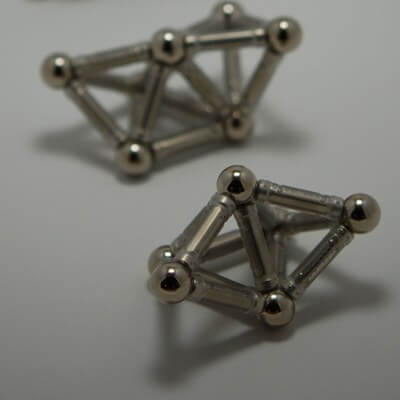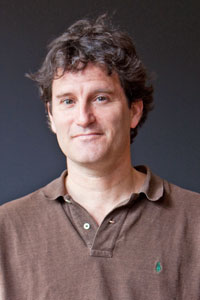News
CAMBRIDGE, MA - January 28, 2010 - Scientists have long studied how atoms and molecules structure themselves into intricate clusters. Unlocking the design secrets of Nature offers lessons in engineering artificial systems that could self-assemble into any desired form.
In the January 29th issue of Science, a team from Harvard led by Vinothan Manoharan and Michael Brenner, presents additional clues to how and why groups of atoms and molecules may favor less symmetrical and more complex, flexible geometric patterns.
The answer relates to a familiar concept in physics—entropy. The researchers literally first caught sight of the link by using magnetic "stick and ball" construction toys.
Manoharan, Associate Professor of Chemical Engineering and Physics in Harvard's School of Engineering and Applied Science (SEAS) and Department of Physics, and his colleagues used colloidal particles, a suspended chemical mixture seen in semi-solid foods like mayonnaise, to simulate the clustering behavior of atoms and molecules.
"To allow clusters to form, we put a few tiny polystyrene spheres in microscopic cylindrical wells filled with water. The particles act as 'sticky' hard spheres and naturally cluster together just like groups of nearby interacting atoms and molecules do," says Manoharan.
The researchers expected that simple, highly symmetric shapes would arise most often. Instead, two surprising, related, and scalable phenomena arose when the number of particles used in their experiments reached six or rose above nine.
Six particles can form into a symmetrical octahedron and into a more complex tri-tetrahedron shape. In terms of chemical structure, each shape results in 12 bonds, and hence, has the same amount of potential energy.
With the potential energy being equal, Manoharan and colleagues thought that both shapes would occur in equal proportion. They found, however, that the tri-tetrahedron occurs 20 times more often than the octahedron.
"The only possible explanation was entropy," says Manoharan. "Most people are familiar with entropy as a measure of 'disorder', but the most useful definition of entropy is simply the number of different ways a bunch of particles can arrange themselves."
Natalie Arkus, a former applied mathematics graduate student who worked with Brenner, Glover Professor of Applied Mathematics and Applied Physics, provided a hint to solving the puzzle, as she discovered a method to calculate all the possible structures that could be formed using geometric magnetic toys (composed of magnetic metal rods and silver ball bearings).
As there are more ways for the complicated tri-tetrahedron structure to form (something that can be directly seen by labeling the toy spheres and counting the ways they can be put together) the shape appears far more frequently than the octahedron. In general, among clusters with the same potential energy, highly symmetric structures are less likely to arise.
The researchers also found that when the number of particles reaches nine or higher, entropy plays another important role.
Because the number of possible structures with nine or more particles is vast, the team focused on what are called non-rigid, or flexible structures. Non-rigidity occurs when a cluster has half-octahedra that share at least one vertex, allowing the cluster to twist without breaking or forming another bond (something also easily seen with the toys).
"Because they can move flexibly, the non-rigid clusters have high vibrational entropy," explains Manohran. "In cases with nine or more particles, symmetric clusters do not appear as often due to rotational entropy. The ability to rotate is useful, as it allows clusters to have extra bonds."
As a general rule, the team found that for all clusters up to 8 particles and a select number of structures with up to 12, the most symmetric structures occurred the least often due to entropy.
"Our findings illustrate, in a tangible way, what the concept of entropy means," says Manohran.
Looking ahead, the researchers are interested in using their results to understand the emergence of bulk crystallization, or how particles come together in the early stages of forming a crystal.
Manoharan and Brenner's co-authors included Guangnan Meng, a research associate in the Department of Physics at Harvard University, and Natalie Arkus, a graduate of SEAS and now a postdoctoral fellow at The Rockefeller University. The authors acknowledge support from the Kavli Institute for Bionanoscience and Engineering; the National Science Foundation; and the Defense Advanced Research Projects Agency.
###
Images and Movies
All images and movies courtesy of Vinothan Manoharan, Harvard School of Engineering and Applied Sciences.
Topics: Applied Physics, Applied Mathematics
Cutting-edge science delivered direct to your inbox.
Join the Harvard SEAS mailing list.
Scientist Profiles
Vinothan N. Manoharan
Wagner Family Professor of Chemical Engineering and Professor of Physics
Michael P. Brenner
Catalyst Professor of Applied Mathematics and Applied Physics and of Physics





